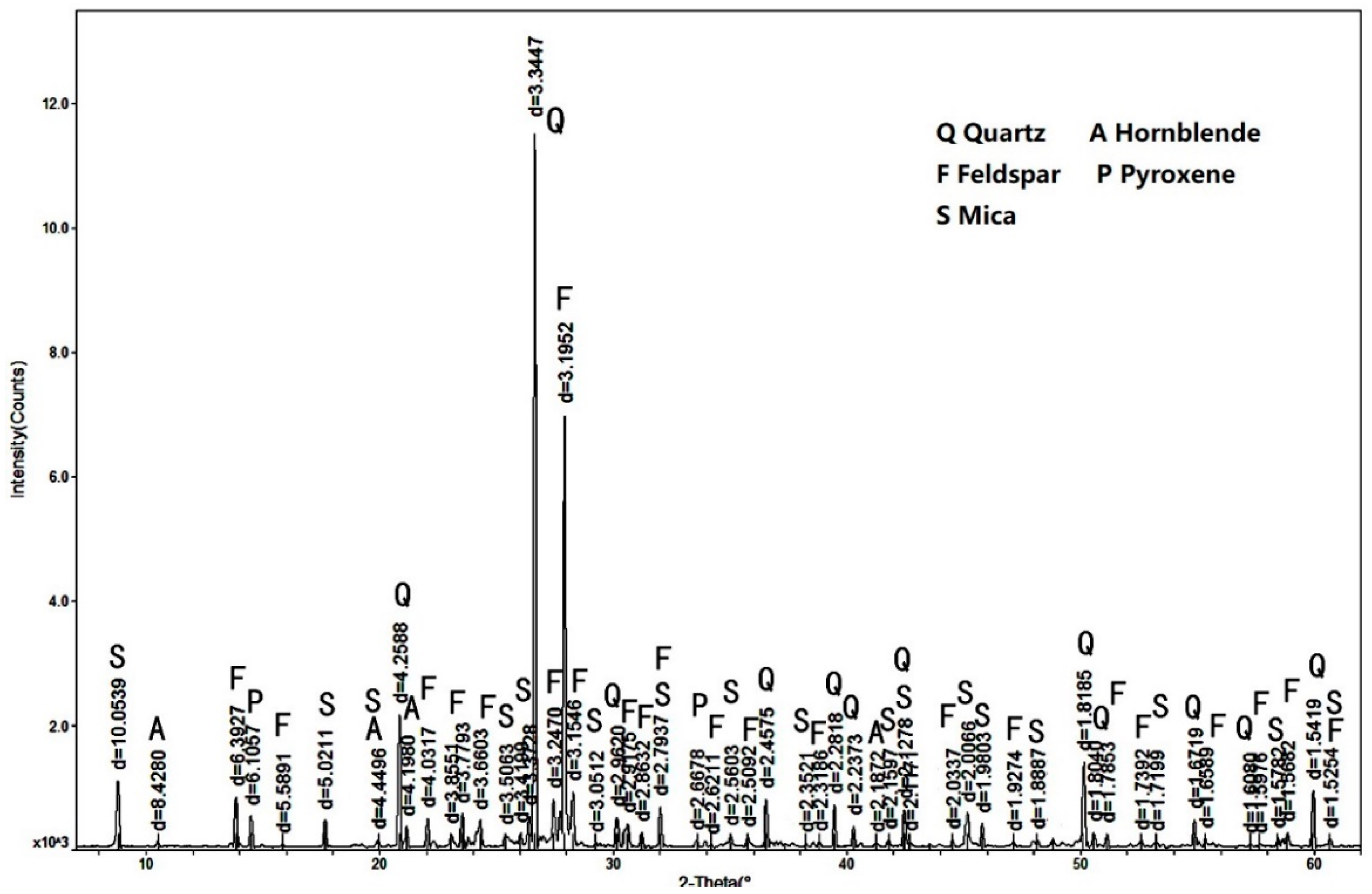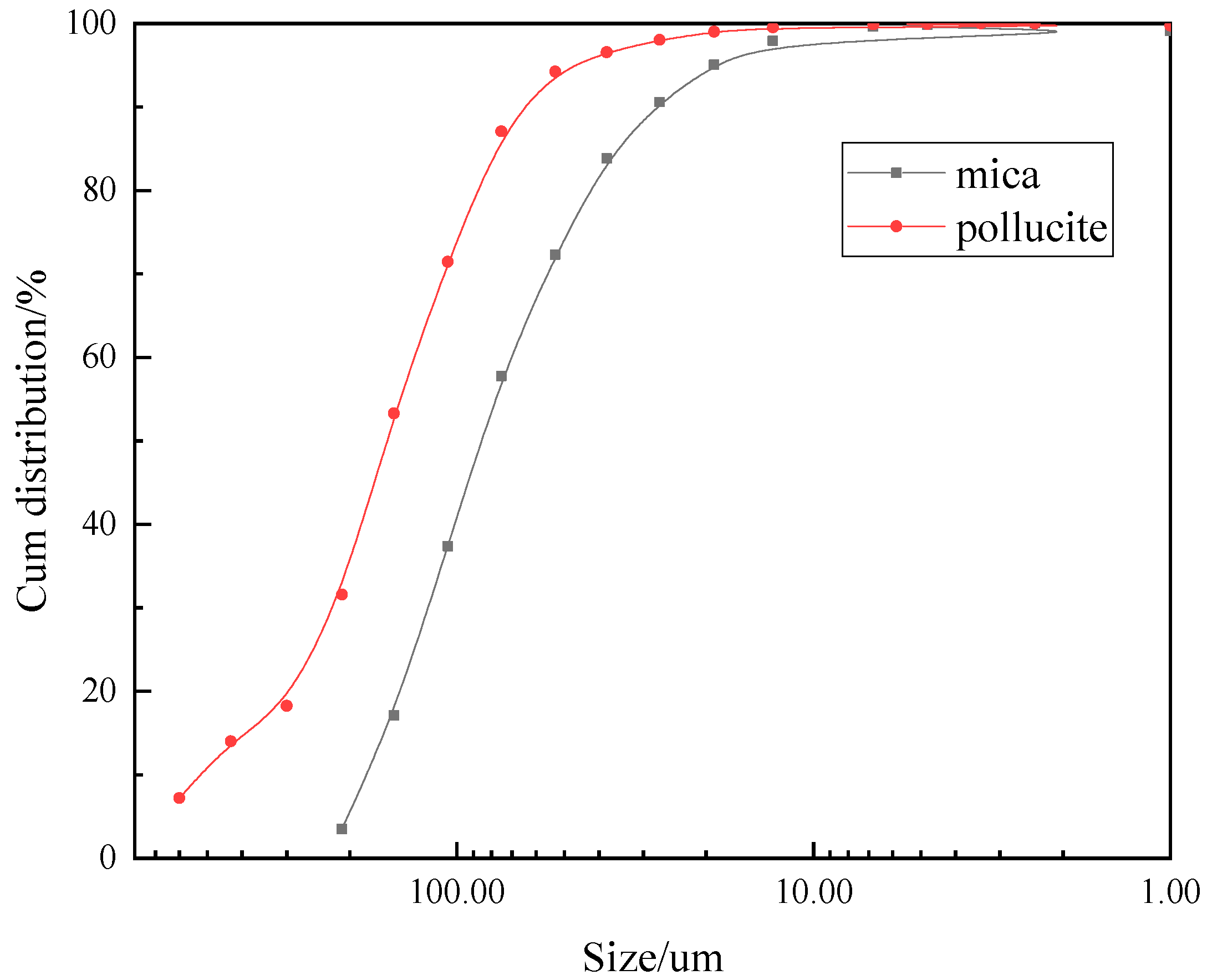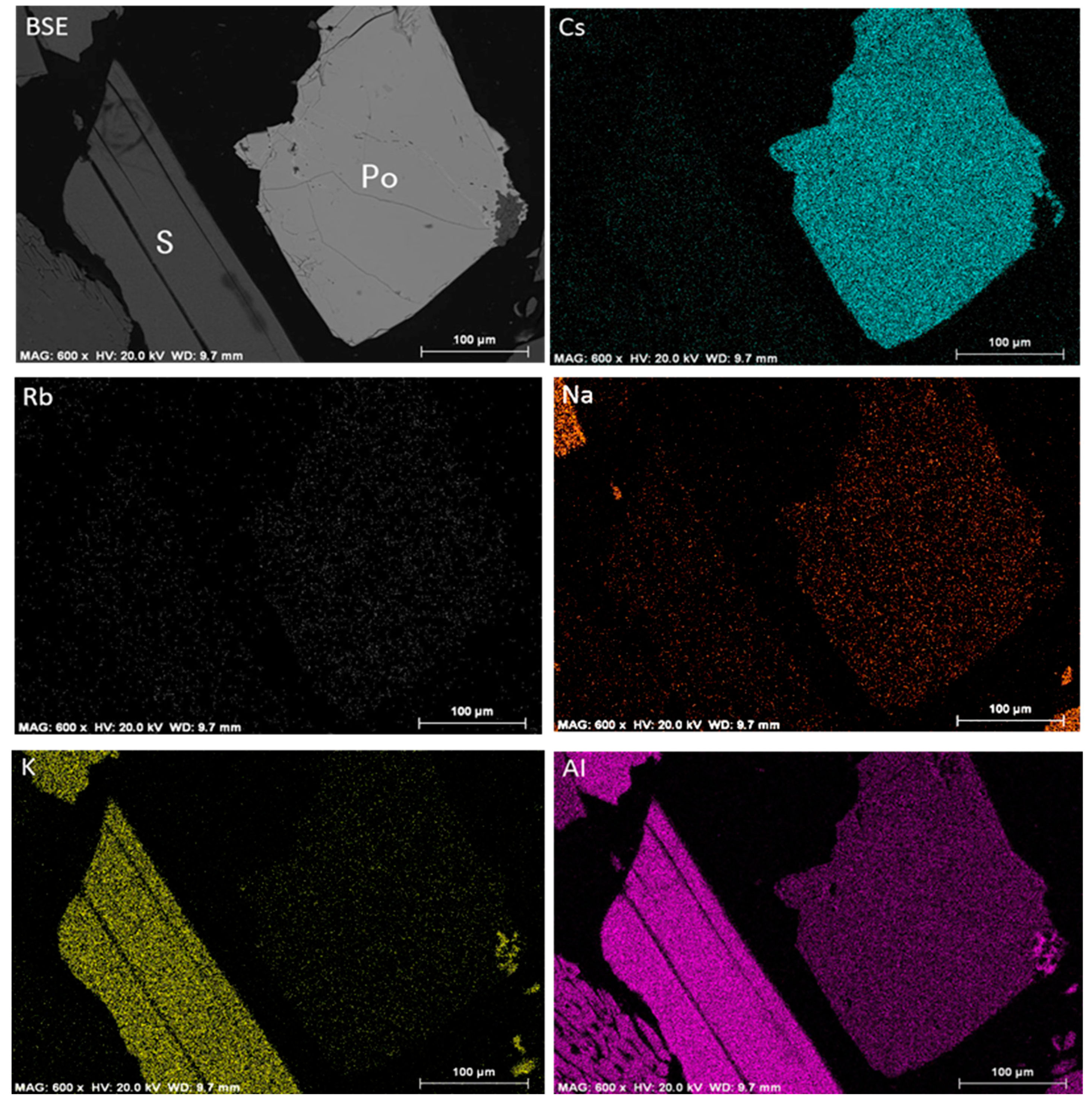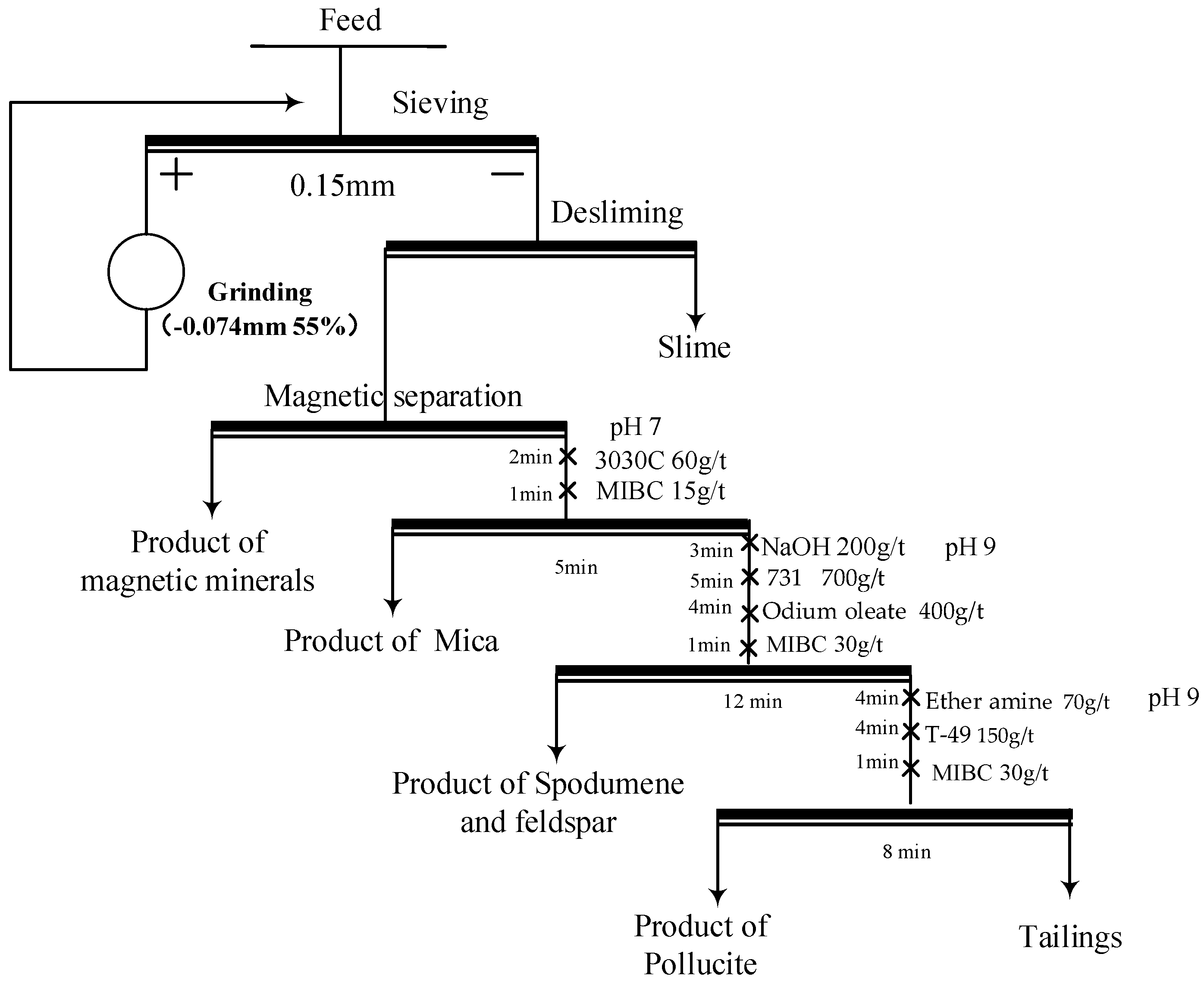Mineralogical Characteristics of Pegmatite Tailings and Beneficiation Assessment of Pollucite in Recovering Cesium
Abstract
:1. Introduction
2. Materials and Methods
2.1. Samples
2.2. Methods
3. Results and Discussion
3.1. Chemical Composition and Analysis
3.2. Mineral Composition and Content of Sample
3.3. Size Characteristics of Main Cesium-Bearing Minerals
3.4. Degree of Liberation of Cesium-Bearing Minerals
3.5. Cesium Content in Cesium-Bearing Minerals
3.6. Occurrence of Cesium-Bearing Minerals
3.7. Pollucite Beneficiation
4. Conclusions
Author Contributions
Funding
Acknowledgments
Conflicts of Interest
References
- Koch, E.C. Special materials in pyrotechnics, Part II: Application of cesium and rubidium compounds in pyrotechnics. J. Pyrotech. 2002, 15, 9–24. [Google Scholar]
- Li, J.P.; Xu, S.H. Eye-forming metals, cesium and rubidium. Chem. World 2015, 85, 108–117. [Google Scholar]
- Huang, W.F.; Li, X.D. Application of cesium and research status of extraction and separation technology. Rare Met. Cem. Carbide 2003, 31, 18–20. [Google Scholar]
- U.S. Geological Survey. Mineral Commodity Summaries; U.S. Geological Survey: Reston, VA, USA, 2022.
- Jia, M.X.; Ying, P.; Fu, Q. Discussion on certain problems on the utilization of some kinds of ore from the view of process mineralogy. Nonferrous Met. Miner. Process. Sect. 2015, 2, 1–4. [Google Scholar]
- Dong, D.; Cheng, H.W.; Guo, B.W.; He, L.J. Present situation and prospect of spodumene beneficiation technology. Prot. Util. Miner. Resour. 2018, 4, 130–134. [Google Scholar]
- Yu, F.S.; Wang, Y.H.; Wang, J.M.; Xie, Z.F. First-principle investigation on mechanism of Ca ion activating flotation of spodumene. Rare Met. 2014, 33, 358–362. [Google Scholar] [CrossRef]
- Li, X.D.; Huang, W.F.; Wen, J.L.; Chen, Y. Study on process mineralogy and mineral processing technology of spodumene ore. Bull. Chin. Ceram. Soc. 2014, 33, 1207–1211. [Google Scholar]
- Liu, J.; Gong, G.C.; Han, Y.X.; Zhu, Y. New insights into the adsorption of oleate on cassiterite: A DFT study. Minerals 2017, 7, 236. [Google Scholar] [CrossRef] [Green Version]
- Xu, L.H.; Peng, T.F.; Tian, J.; Lu, Z.; Hu, Y.; Sun, W. Anisotropic surface physicochemical properties of spodumene and albite crystals: Implications for flotation separation. Appl. Surf. Sci. 2017, 426, 1005–1015. [Google Scholar] [CrossRef]
- Chen, J.H.; Chen, Y.; Li, Y.Q. Effect of vacancy defects on electronic properties and activation of sphalerite(110)surface by first principles. Trans. Nonferrous Met. Soc. China 2010, 20, 502–506. [Google Scholar] [CrossRef]








| Froth Flotation Stage | Collector | Reagent Grade | Reagent Company |
|---|---|---|---|
| Mica | 3030C | - | Solvi |
| Spodumene and Feldspar | Oxidized paraffin soap 731 Odium oleate | Industrial grade | Bei Zhen City Lvfeng Chemical plant, Jinzhou, China |
| Pollucite | Ether amine T-49 | Industrial grade | Yunnan Yuntong Tiefeng ore dressing Pharmaceutical Co., Ltd., Chuxiong, China |
| Element | Rb | Cs | Ta | Ga | Ge | Cu | Zn | Sr |
|---|---|---|---|---|---|---|---|---|
| Content, % | 0.158 | 0.286 | 0.01 | 0.008 | 0.001 | 0.005 | 0.007 | 0.003 |
| Element | Zr | Ti | Cr | Fe | Mn | Si | Al | Ca |
| Content, % | 0.001 | 0.017 | 0.006 | 0.373 | 0.072 | 33.53 | 7.133 | 0.222 |
| Element | Mg | K | Na | P | S | F | ||
| Content, % | 0.032 | 1.6 | 2.91 | 0.64 | 0.01 | 0.32 |
| Constituent | Li2O | Rb2O | Cs2O | Ta2O5 | Nb2O5 | FeO | MnO | F |
|---|---|---|---|---|---|---|---|---|
| Content, % | 1.16 | 0.34 | 0.51 | 0.037 | 0.006 | 0.43 | 0.069 | 0.21 |
| Constituent | Al2O3 | CaO | MgO | K2O | Na2O | SiO2 | P | Ig |
| Content, % | 13.52 | 0.34 | 0.063 | 1.93 | 3.64 | 74.51 | 0.48 | 2.755 |
| Cesium Phase | Cs2O in Mica | Cs2O in Pollucite | Cs2O in Others | Total |
|---|---|---|---|---|
| Content, % | 0.067 | 0.424 | 0.018 | 0.509 |
| Proportion of total cesium, % | 13.16 | 83.30 | 3.54 | 100.00 |
| Mineral | Monomer, % | Intergrowth, % | |||
|---|---|---|---|---|---|
| >3/4 | 3/4~1/2 | 1/2~1/4 | <1/4 | ||
| pollucite | 76.33 | 8.92 | 10.77 | 2.57 | 1.41 |
| mica | 84.38 | 6.45 | 4.86 | 2.45 | 1.86 |
| Number | Content, % | ||||
|---|---|---|---|---|---|
| Cs2O | Rb2O | Na2O | Al2O3 | SiO2 | |
| 1 | 34.39 | 0.00 | 2.23 | 17.16 | 44.73 |
| 2 | 33.56 | 0.00 | 2.63 | 17.27 | 45.04 |
| 4 | 34.46 | 0.00 | 2.62 | 16.81 | 44.61 |
| 5 | 33.24 | 0.00 | 2.66 | 17.44 | 45.15 |
| 6 | 34.15 | 0.88 | 2.20 | 16.63 | 44.65 |
| 7 | 33.88 | 0.55 | 2.35 | 16.82 | 44.89 |
| 8 | 33.74 | 0.00 | 2.67 | 16.99 | 45.10 |
| 9 | 36.86 | 0.00 | 1.55 | 15.29 | 44.81 |
| Average | 34.28 | 0.18 | 2.36 | 16.80 | 44.87 |
| Number | Content, % | ||||
|---|---|---|---|---|---|
| Cs2O | Rb2O | K2O | FeO | MnO | |
| 1 | 0.12 | 2.55 | 11.09 | 0.37 | 0.05 |
| 2 | 0.16 | 2.69 | 10.09 | 0.81 | 0.08 |
| 3 | 0.59 | 4.08 | 9.19 | 0.25 | 0.88 |
| 4 | 0.08 | 3.39 | 9.92 | 0.58 | 0.06 |
| 5 | 0.05 | 2.24 | 10.70 | 0.96 | 0.22 |
| 6 | 0.72 | 3.10 | 10.38 | 0.99 | 0.37 |
| 7 | 0.16 | 2.40 | 10.48 | 1.26 | 0.05 |
| 8 | 0.15 | 2.28 | 10.99 | 1.29 | 0.05 |
| 9 | 0.30 | 3.54 | 9.11 | 2.43 | 0.11 |
| Average | 0.25 | 2.84 | 10.36 | 0.81 | 0.22 |
| Product | Yield, % | Grade (Cs2O), % | Recovery (Cs2O), % |
|---|---|---|---|
| Slime | 8.92 | 0.22 | 3.88 |
| Fe minerals | 3.04 | 0.21 | 1.26 |
| Mica | 7.21 | 0.32 | 4.56 |
| Spodumene and feldspar | 43.06 | 0.22 | 18.73 |
| Pollucite | 7.24 | 4.45 | 63.71 |
| Tailings | 30.53 | 0.13 | 7.85 |
| Feed | 100.00 | 0.51 | 100.00 |
Publisher’s Note: MDPI stays neutral with regard to jurisdictional claims in published maps and institutional affiliations. |
© 2022 by the authors. Licensee MDPI, Basel, Switzerland. This article is an open access article distributed under the terms and conditions of the Creative Commons Attribution (CC BY) license (https://creativecommons.org/licenses/by/4.0/).
Share and Cite
Chen, Y.; Wen, J.; Song, Y.; Li, W.; Liu, S.; Liu, Y. Mineralogical Characteristics of Pegmatite Tailings and Beneficiation Assessment of Pollucite in Recovering Cesium. Minerals 2022, 12, 541. https://doi.org/10.3390/min12050541
Chen Y, Wen J, Song Y, Li W, Liu S, Liu Y. Mineralogical Characteristics of Pegmatite Tailings and Beneficiation Assessment of Pollucite in Recovering Cesium. Minerals. 2022; 12(5):541. https://doi.org/10.3390/min12050541
Chicago/Turabian StyleChen, Yong, Jiankang Wen, Yongsheng Song, Wenjuan Li, Shuang Liu, and Ying Liu. 2022. "Mineralogical Characteristics of Pegmatite Tailings and Beneficiation Assessment of Pollucite in Recovering Cesium" Minerals 12, no. 5: 541. https://doi.org/10.3390/min12050541
APA StyleChen, Y., Wen, J., Song, Y., Li, W., Liu, S., & Liu, Y. (2022). Mineralogical Characteristics of Pegmatite Tailings and Beneficiation Assessment of Pollucite in Recovering Cesium. Minerals, 12(5), 541. https://doi.org/10.3390/min12050541






